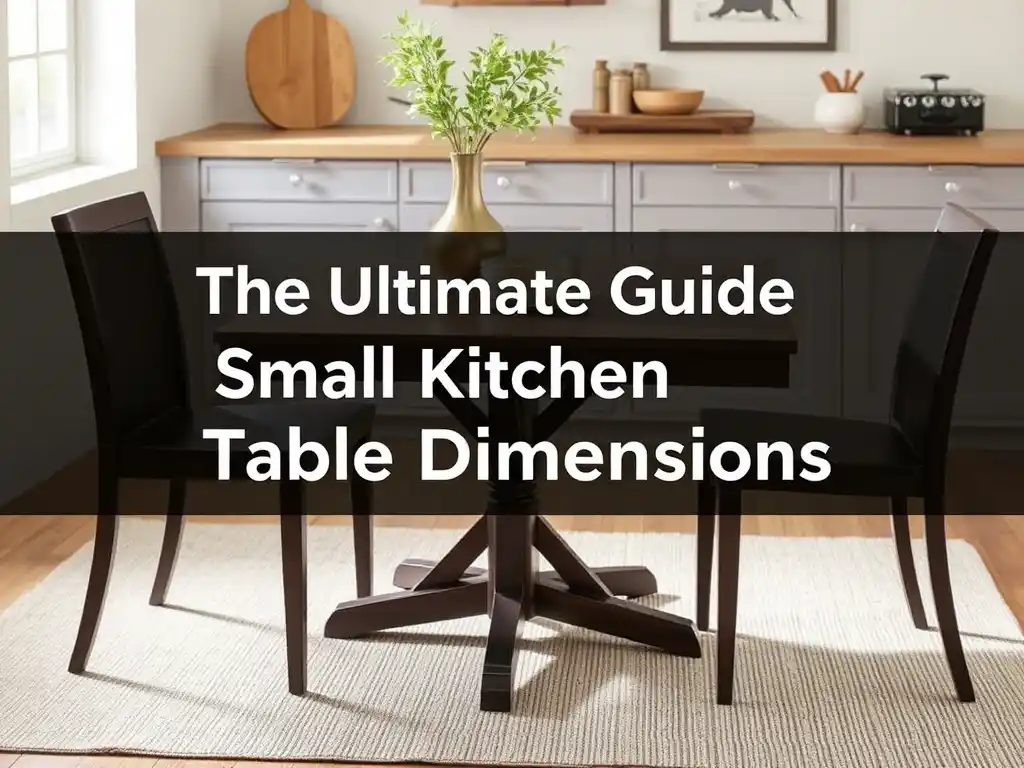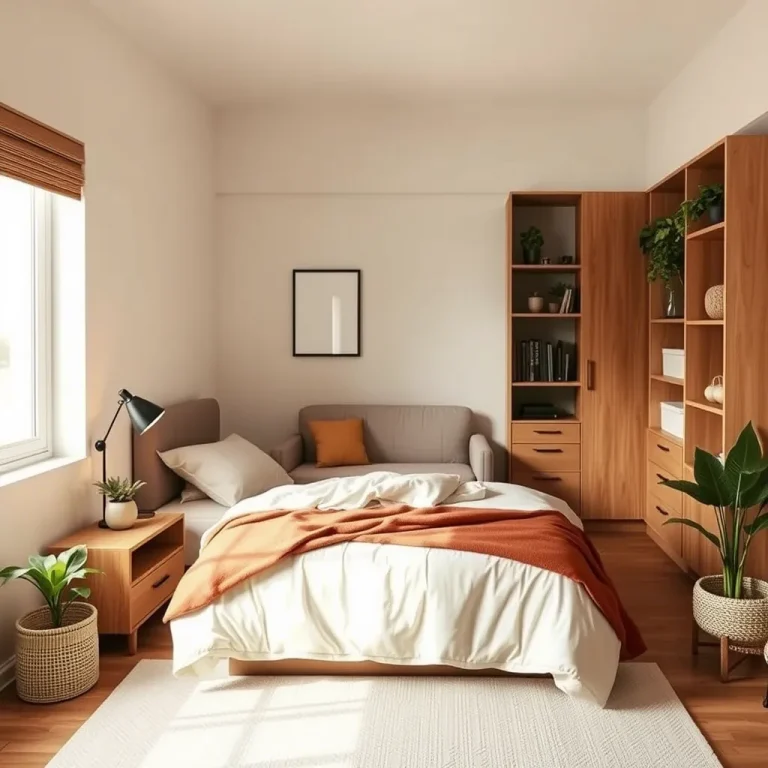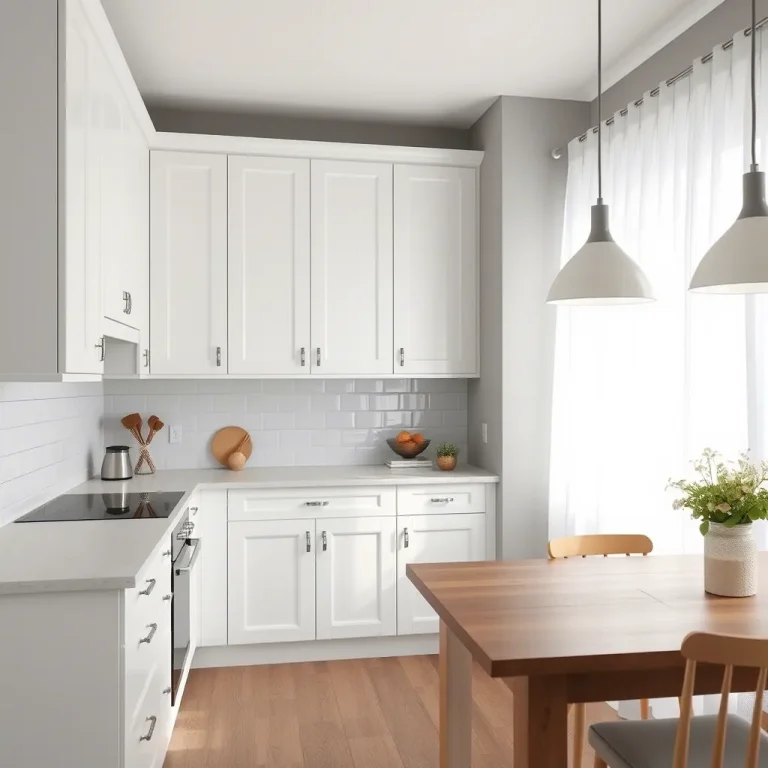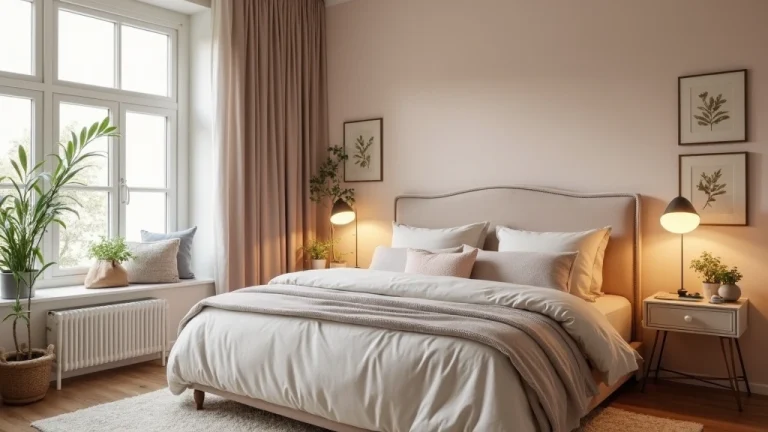
Are you struggling to find the perfect table for your small kitchen? You’re not alone! Many homeowners face the challenge of maximizing space while creating a functional dining area. The right table can make all the difference in a compact kitchen.
This guide is your ultimate resource for small kitchen table dimensions. We’ll explore standard sizes, factors to consider when choosing, and popular options that fit snugly in tight spaces. Whether you’re furnishing a cozy apartment or optimizing a breakfast nook, we’ve got you covered.
From space-saving designs to measurement tips, we’ll help you find the ideal table that fits your kitchen and lifestyle. Get ready to transform your small kitchen into a comfortable and stylish dining space!
Contents
- Standard Small Kitchen Table Dimensions
- Square and Round Tables: Compact and Versatile
- Rectangular and Oval Tables: Maximizing Narrow Spaces
- Height Considerations: Comfort is Key
- Space Around the Table: Ensuring Ease of Movement
- Multifunctional and Space-Saving Options
- 4 Factors to Consider When Choosing Dimensions
- 1. Available space in your kitchen
- 2. Number of people to accommodate
- 3. Shape considerations (round vs. rectangular)
- 4. Clearance space around the table
- Popular Small Kitchen Table Sizes: How to Measure Your Space?
- A. 2-person tables
- B. 4-person tables
- C. Expandable options for flexibility
- 10 Space-Saving Kitchen Table Design Ideas
- 1. Drop-Leaf Tables
- 2. Wall-Mounted Tables
- 3. Extendable Tables
- 4. Corner Nook Tables
- 5. Folding Tables
- 6. Multi-Functional Islands
- 7. Built-In Tables
- 8. Bar-Height Tables
- 9. Compact Bistro Sets
- 10. Hidden Tables
- FAQs
- A. What’s the smallest kitchen table size available?
- B. Can I use a small kitchen table in other rooms?
- C. How much space should I leave around a small kitchen table?
- Conclusion
- Related
Standard Small Kitchen Table Dimensions

When it comes to small kitchen tables, finding the right dimensions can make a world of difference! Small kitchen tables are perfect for cozy apartments, breakfast nooks, or any area where space is limited.
So, what are the standard dimensions for these compact wonders? Let’s get the details!
Square and Round Tables: Compact and Versatile

One of the most common shapes for small kitchen tables is the square. These tables typically start at around 24 inches by 24 inches. This size is perfect for two people and can fit snugly into a corner or against a wall.
For a slightly larger option, a 30-inch by 30-inch table can comfortably seat four people, making it ideal for small families or those who enjoy having friends over for coffee or a casual meal.
Round tables are another popular choice for small kitchens. A table with a diameter of 30 inches can usually seat two to three people comfortably.
The advantage of a round table is that it often feels more spacious because there are no sharp corners. Which can help create a smoother flow in a tight space. A 36-inch diameter round table can accommodate four people and still maintain a compact footprint.
Rectangular and Oval Tables: Maximizing Narrow Spaces

Rectangular Tables: For kitchens that are narrow but have some length, a small rectangular table might be the best fit. A table measuring 24 inches by 36 inches can seat two people along one side or one person on each side with a bit more elbow room.
If you have a little more space, a 30-inch by 48-inch table can comfortably seat four people. It also provides a nice balance between dining and kitchen workspace.
Oval tables offer a blend of the space efficiency of rectangular tables and the flow of round tables. A small oval table with dimensions around 30 inches by 42 inches can seat four people and is particularly good for small dining areas that need to make the most of their layout.
Height Considerations: Comfort is Key
While the tabletop dimensions are crucial, the height of the table is also important for comfort and usability. Standard dining table height ranges from 28 to 30 inches. This height works well with most dining chairs, which typically have a seat height of 18 inches.
When using a small kitchen table for other purposes, like work desk or craft table, you can consider a different height.
Space Around the Table: Ensuring Ease of Movement

To make sure your small kitchen table doesn’t feel cramped, it’s important to leave adequate space around it. Aim to have at least 30 inches of clearance on all sides. This allows for easy movement and enough room for chairs. It’s to be pulled out and pushed in without bumping into walls or other furniture.
In tighter spaces, you get away with 24 inches of clearance. But this should be the minimum to ensure a comfortable dining experience.
Multifunctional and Space-Saving Options
Small kitchen tables often need to serve multiple purposes. Consider options that offer additional features like drop leaves, which allow you to extend the table when needed and fold it down to save space when it’s not in use.
Tables with built-in storage, such as shelves or drawers, can also be incredibly useful in maximizing functionality.
Here’s a table summarizing the standard small kitchen table dimensions:
| Table Shape | Dimensions (inches) | Seating Capacity | Description |
|---|---|---|---|
| Square | 24 x 24 | 2 | Ideal for very tight spaces or corners. |
| 30 x 30 | 4 | Comfortable for a small family or friends. | |
| Round | 30 diameter | 2-3 | Compact and smooth, fits well in tight spaces. |
| 36 diameter | 4 | Provides more room while remaining compact. | |
| Rectangular | 24 x 36 | 2 | Great for narrow spaces, seating on one or both sides. |
| 30 x 48 | 4 | Offers extra space and can seat four comfortably. | |
| Oval | 30 x 42 | 4 | Combines space efficiency with a smooth flow. |
This table can help you visualize and choose the best small kitchen table dimensions for your space!
4 Factors to Consider When Choosing Dimensions

finding the right dimensions is like solving a puzzle where the pieces are your space, your needs, and your lifestyle. Take your time, measure twice, and don’t be afraid to tape out the dimensions on your floor to get a real feel for the size.
To help you out, here are my tips for you –
1. Available space in your kitchen

Alright, let’s start with the obvious – how much room do you actually have? It’s not just about cramming a table in there. You need to think about the overall flow of your kitchen. Grab a tape measure and figure out your free space.
Pro tip: leave about 3 feet of clearance around where you want your table. Trust me, future you will thank past you when you’re not doing an awkward shimmy just to get to the fridge.
2. Number of people to accommodate

Time for a reality check. Who’s going to be using this table on the regular? If it’s just you and your Netflix account most nights, a cozy two-seater might do the trick. But if you’ve got a family of four or love hosting brunch, you’ll need to think bigger.
Don’t forget about the occasional guest – maybe a table with a fold-out leaf could give you that extra flexibility?
3. Shape considerations (round vs. rectangular)

Shape matters, folks! Round tables are the unsung heroes of small spaces. No sharp corners to hip-check as you walk by, plus they have this magical ability to make everyone feel included in the conversation.

Rectangular tables are classic for a reason, though. They can snug up against a wall when you need extra floor space, and they’re great for multitasking if your “kitchen table” doubles as your “work desk.”
4. Clearance space around the table

Here’s where a lot of people trip up! You need room to, well, live around your table.
Can you pull out the chairs without hitting a wall? Can Uncle Bob get up from the table without knocking over a plant? Give yourself some breathing room – your shins and your guests will appreciate it.
Popular Small Kitchen Table Sizes: How to Measure Your Space?

Measuring isn’t just about finding out what fits—it’s about figuring out what works for your space and lifestyle. Take your time, be thorough, and maybe rope in a friend to help! So, let me be your friend!
A. 2-person tables

These little gems are perfect for cozy couples or solo dwellers. We’re typically looking at about 30-36 inches in diameter for round tables, or 30-36 inches square for, well, square ones.
Rectangular? Think 30-36 inches wide by 36-48 inches long. They’re compact but still give you enough room to spread out your Sunday paper.
B. 4-person tables

The family-friendly option! For round tables, you’re looking at 36-48 inches in diameter. Rectangular tables usually run about 36 inches wide by 48-60 inches long. It’s enough space for family dinners without feeling like you’re dining in a cafeteria.
C. Expandable options for flexibility

These are the shapeshifters of the table world. Drop-leaf or extendable tables can go from intimate dinners for two to hosting a small gathering.
When collapsed, they might be as small as 30-36 inches but can expand to 60 inches or more. Talk about having your cake and eating it too!
How to Measure Your Space for a Kitchen Table?
Measuring is not that easy for the newbie. So, here I am to help you out –
- Clear the area: Move out any furniture or clutter. You want a blank canvas.
- Measure the entire room: Get the full dimensions of your kitchen. Knowledge is power, folks!
- Mark your ideal table area: Use painter’s tape on the floor to outline where you want your table.
- Measure your outline: Get the width and length of your taped area.
- Don’t forget height: Measure from floor to ceiling, especially if you’re considering a tall table.
Tips for accuracy
- Use a metal tape measure, not a cloth one. Cloth can stretch and give you inaccurate readings.
- Measure twice, buy once. Double-check all your measurements.
- Note any weird angles, protruding pipes, or other quirks in your kitchen.
- Remember to account for light fixtures or low-hanging cabinets that might impact table height.
- Leave at least 36 inches of clearance for walkways around the table.
10 Space-Saving Kitchen Table Design Ideas
Thinking about ideas for a small kitchen table? We’ve got you covered! Let’s share the 10 best kitchen tables for you!
1. Drop-Leaf Tables

Drop-leaf tables have one or two hinged sections (leaves) that can be folded down when the table isn’t in use.
Benefits
- Space Efficiency: Perfect for small kitchens where space is at a premium.
- Versatility: Can be expanded for dining and collapsed for everyday use.
- Style Options: Available in various styles, from rustic farmhouse to modern minimalist.
Variations
- Single Drop-Leaf: One side folds down, ideal for placing against a wall.
- Double Drop-Leaf: Both sides fold down, providing even more flexibility in space usage.
2. Wall-Mounted Tables

These tables are attached to the wall and can be folded down when not needed.
Benefits
- Floor Space: Frees up floor space, making the kitchen appear larger.
- Easy Installation: Can be installed at any height to suit your needs.
- Functionality: Doubles as a work or prep surface when folded down.
Variations
- Shelf Combo: Some designs incorporate shelves above the table for extra storage.
- Adjustable Height: Certain models allow you to adjust the height for different uses.
3. Extendable Tables

Extendable tables feature leaves that can be added or removed to adjust the size of the table.
Benefits
- Flexibility: Easily adjusts to accommodate more guests when needed.
- Compact Storage: Leaves can often be stored within the table itself.
- Durability: Many models are built to be sturdy and long-lasting.
Variations
- Butterfly Leaf: The leaf folds and stores inside the table, making it easy to extend.
- Drop-In Leaf: Separate leaves are added to extend the table, offering more flexibility in length.
4. Corner Nook Tables

Corner nook tables are designed to fit into a corner, often with built-in bench seating.
Benefits
- Efficient Use of Space: Utilizes corner areas that might otherwise go unused.
- Cozy Seating: Creates a warm and inviting dining nook.
- Storage: Some designs include storage under the benches.
Variations
- L-shaped bench: Maximizes seating capacity in a small area.
- U-shaped bench: Provides even more seating and a more intimate dining experience.
5. Folding Tables

Folding tables can be completely collapsed and stored away when not in use.
Benefits
- Portability: Easy to move and store, perfect for multipurpose spaces.
- Compact: Takes up minimal space when folded.
- Versatility: Can be used as a temporary dining area or additional workspace.
Variations
- Wall-Folding: Attaches to the wall and folds down for use.
- Freestanding: A standalone table that folds flat for storage.
6. Multi-Functional Islands

Kitchen islands that double as dining tables or have a pull-out table feature.
Benefits
- Dual Purpose: Functions as both a workspace and dining area.
- Additional Storage: Often includes cabinets or drawers for extra storage.
- Stylish: Adds a focal point to the kitchen.
Variations
- Pull-Out Table: A table that pulls out from the island when needed.
- Convertible: An island with a tabletop that can be raised or extended for dining.
7. Built-In Tables

Built-in tables are integrated into the kitchen cabinetry or island.
Benefits
- Seamless Design: Creates a cohesive look within the kitchen.
- Space Saving: Eliminates the need for a separate table.
- Customizable: Can be tailored to fit your specific kitchen layout.
Variations
- Cabinet Extension: A tabletop that extends from the cabinetry.
- Island Attachment: A table built into the side of the kitchen island.
8. Bar-Height Tables

Taller tables, typically paired with bar stools, offer a casual dining experience.
Benefits
- Visual Space: Takes up less visual space, making the kitchen feel larger.
- Multipurpose: Can be used for dining, working, or extra counter space.
- Stylish: Adds a modern, casual vibe to the kitchen.
Variations
- Counter-Height: Slightly lower than bar height, offering a more traditional seating height.
- Narrow Design: A slim table that fits well in tight spaces.
9. Compact Bistro Sets

Small, stylish tables paired with two chairs, inspired by café settings.
Benefits
- Charming Aesthetic: Adds a touch of elegance and charm to the kitchen.
- Space Efficient: Perfect for small dining areas or breakfast nooks.
- Easy to Move: Lightweight and easy to rearrange as needed.
Variations
- Folding Chairs: Chairs that can be folded and stored away when not in use.
- Stackable Chairs: Chairs that stack to save space when not in use.
10. Hidden Tables

Tables that can be concealed within cabinets or drawers.
Benefits:
- Clutter-Free: Keeps the kitchen looking tidy and open.
- Surprise Element: Adds a fun, functional surprise element to the kitchen design.
- Practical: Provides dining space when needed and hides away when not in use.
Variations
- Drawer Table: A table that pulls out from a drawer unit.
- Cabinet Table: A table that folds out from within a cabinet
Related Reads:
To get more information about small kitchen table dimensions, here’s a video to help you out!
FAQs
Want to learn more about kitchen table size? Check the following queries to get some help!
A. What’s the smallest kitchen table size available?
The smallest kitchen table size typically starts at around 24 inches by 24 inches. These compact tables are ideal for very tight spaces or small apartments.
B. Can I use a small kitchen table in other rooms?
Yes, a small kitchen table can be used in other rooms such as a home office, living room, or even as a bedside table. Its versatility makes it suitable for various purposes.
C. How much space should I leave around a small kitchen table?
Leave at least 30 inches of space around a small kitchen table for comfortable movement and seating. This ensures easy access and enough room for chairs to be pulled out.
Conclusion
Choosing the right small kitchen table is all about balancing size, functionality, and style. By considering factors like available space, seating needs, and table shape, you can find the perfect fit for your compact kitchen. Remember to measure carefully and leave enough clearance for comfortable movement.
With the variety of space-saving designs available, from drop-leaf tables to wall-mounted options, there’s a solution for every small kitchen. Embrace the challenge and turn your limited space into a cozy, efficient dining area that you’ll love using every day.





